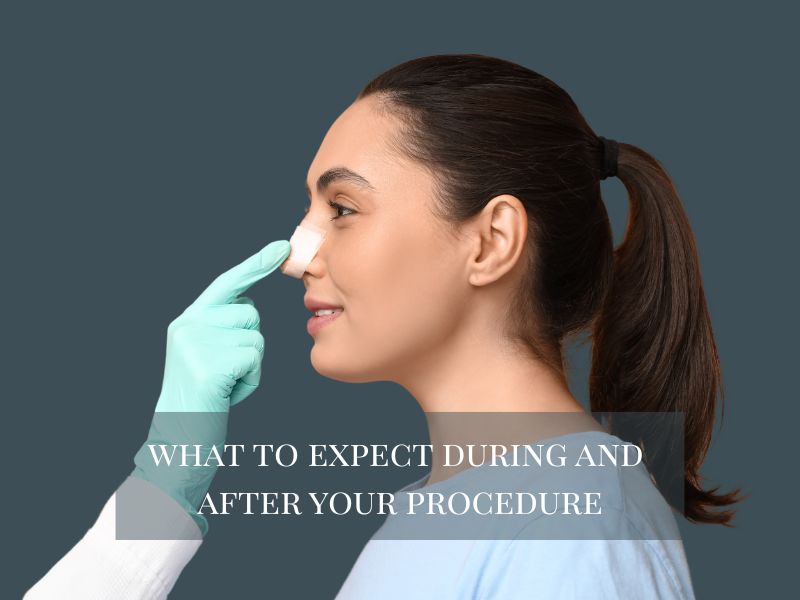Non-surgical rhinoplasty uses dermal fillers to shape and contour the nose. You may also hear the procedure called a liquid nose job.
It’s a popular choice for individuals seeking to refine the appearance of their noses without undergoing the more traditional option of surgery. Let’s talk about what a non surgical rhinoplasty is and if you can benefit from this alternative to a surgical nose job.
Non-Surgical Rhinoplasty vs. Surgical Rhinoplasty

While non-surgical rhinoplasty uses fillers to create changes in the shape of the nose, surgical rhinoplasty requires that a skilled surgeon create precise incisions that allow them to reshape the nose.
While surgical rhinoplasty gives a surgeon more precise access to your nose, the non-surgical option is an accurate way to get very similar results without the risks associated with all the different rhinoplasty surgeries.
Since it uses dermal fillers to reshape and contour the nose, the results are temporary, typically lasting 6-18 months. They can be adjusted and tweaked as desired.
Additionally, it can be performed in an office setting, often taking 15-30 minutes to complete. This allows you to return to normal activities immediately after the procedure. On the other hand, many people elect to have surgical rhinoplasty due to its permanent nature.
Advantages of Choosing Non-Surgical Rhinoplasty
Non-surgical rhinoplasty offers advantages such as minimal downtime, reduced risk, and the ability to adjust the shape of your nose without the need for invasive surgery. It’s a convenient option for those seeking temporary changes or individuals who have previously undergone rhinoplasty and desire further refinement.
Potential Limitations
While it provides quick results and minimal downtime, the effects are not permanent. The filler used may migrate over time, and temporary redness or asymmetry may require touch-ups.
What to Expect During and After Your PROCEDURE

You may experience slight redness or swelling, but these side effects should go away within a few days at most. One of the things people love most about non-surgical rhinoplasty is the lack of downtime. You may need to take a few days off from strenuous activities, but you can return to daily living activities right after the non surgical procedure.
If you experience any prolonged or severe discomfort, redness, swelling, or other unexpected symptoms, it’s important to contact your healthcare provider immediately. Make sure to attend follow up appointments with your board certified plastic surgeon for maintenance and monitoring.
Frequently Asked Questions
What fillers are commonly used in non-surgical rhinoplasty?
The most commonly used fillers in non-surgical rhinoplasty include hyaluronic acid-based fillers such as Restylane, Juvederm, and Radiesse, which are injected to reshape and enhance the appearance of the nose.
Is non-surgical rhinoplasty permanent?
Non-surgical rhinoplasty using injectable fillers offers temporary results, typically lasting between 6 months to 2 years, depending on the type of filler material used and individual metabolism. Repeat treatments are needed to maintain the desired aesthetic outcome.
How much does it cost?
The cost can range based on your provider and location. The average cost ranges from $800 to $2500 per non surgical rhinoplasty treatment session. The average cost of one syringe is usually between $600-$750, but different people may need more or less product.
How to start your rhinoplasty aftercare
Starting your rhinoplasty aftercare properly begins with keeping your head elevated at 30-45 degrees for the first week using multiple pillows. Apply cold compresses to the eyes during the first 72 hours to reduce swelling, being careful not to wet the nasal splint.
Begin with a light liquid diet immediately after surgery, progressing to soft foods the next day. Keep the nasal splint dry and intact until your doctor removes it, and clean inside your nostrils with hydrogen peroxide on a Q-tip to prevent crust formation.
Follow your surgeon’s specific instructions closely and attend all follow-up appointments for proper monitoring. Remember that swelling is normal and peaks at 48-72 hours, so patience during initial healing is essential for optimal results.
Can non-surgical rhinoplasty address the appearance of my nose after a previous rhinoplasty surgery?
It can be used to correct the results of a previous rhinoplasty procedure, providing subtle enhancements without the need for further surgical intervention. Discuss this option with your healthcare provider to determine if your desired outcome is realistic.
Is a topical anesthetic used during non surgical nose job?
Yes, a topical anesthetic is commonly applied before the non surgical rhinoplasty procedure to minimize discomfort during the injection of fillers and ensure a comfortable experience.
What changes to the nose's appearance can be achieved through nonsurgical rhinoplasty?
It can address concerns such as dorsal (bridge) hump reduction, nasal bridge augmentation, correction of nasal asymmetry, refinement of the nasal tip, and camouflage of minor irregularities, resulting in an improved overall appearance of the nose.
Can I choose a non surgical nose job instead of facial plastic surgery, and what should they expect?
Many patients seeking minor nasal changes can avoid facial plastic surgery with a non surgical nose job. The procedure uses dermal fillers and topical numbing cream for comfort.
You’ll discuss your treatment plan with your qualified provider, but dramatic changes still require patients to do a surgery.
Is it safe to get a non surgical nose job?
Yes, a nonsurgical rhinoplasty is generally considered safe for most patients seeking subtle changes without facial plastic surgery. This injectable treatment uses many dermal fillers, such as hyaluronic acid, for precise filler placement.
Topical numbing cream is applied before filler injections, and your treatment plan is customized to your goals. While effective, dramatic results may still require patients to undergo surgery.
How does nasal anatomy affect nasal appearance and facial features, and what can I expect after treatment?
Nasal anatomy, including bones and cartilage, shapes your nasal appearance and influences your overall facial features. After treatment, minor swelling is common but usually resolves quickly, helping restore both function and aesthetics.
At what age can you get a liquid rhinoplasty?
Non-surgical rhinoplasty, or liquid rhinoplasty, is suitable for women and men over the age of 18 who are unhappy with the shape of their noses. However, this procedure does not address breathing difficulties or functional nasal issues.
How does a surgical procedure vs non-surgical approach address a flat nasal bridge
A surgical procedure can permanently reshape a low nasal bridge using implants or cartilage grafts, offering dramatic and lasting changes. In contrast, a non-surgical approach, such as liquid rhinoplasty, uses dermal fillers to temporarily add volume and contour to the bridge, with minimal downtime and immediate results.
However, the nasal region contains a dense network of blood vessels, making both approaches potentially risky if not performed by an experienced professional.
What should I expect during the recovery period after revision rhinoplasty, and is non-surgical rhinoplasty an option?
The recovery period typically lasts one to two weeks, with minimal discomfort for most patients. For those seeking subtle changes without surgery, non-surgical rhinoplasty using dermal fillers may be an alternative, though it cannot address all concerns corrected by surgery.
Can a deviated septum be fixed without surgery?
A deviated septum itself cannot be fixed non-surgically, but several non-surgical options can help manage symptoms and improve breathing.
These include medical treatments like nasal decongestants, antihistamines, and corticosteroid sprays, as well as non-drug methods such as nasal strips, saline irrigation, humidifiers, and breathing exercises.
For severe symptoms or persistent breathing difficulties, surgery may be necessary.
Who is an appropriate candidate for non-surgical rhinoplasty?
Non-surgical rhinoplasty is best for individuals seeking to address cosmetic issues, such as minor changes in nose size or shape, without surgery. It is not suitable for those with breathing problems, as it cannot correct structural issues.
Appropriate candidates are in good health, have a clear medical history, and hold realistic expectations about procedure results, understanding that improvements are subtle and temporary.
Does non surgical rhinoplasty leave scars?
Non-surgical rhinoplasty, does not cause scars because there are no cuts. The procedure uses dermal fillers administered through very fine needles that leave no scarring behind.
In contrast, surgical rhinoplasty may leave scars, especially with open rhinoplasty. However, modern surgical techniques have made visible scarring very uncommon. The type and visibility of scars depends on the surgical approach.
How to prepare for surgical and non-surgical rhinoplasty?
Preparation for surgical rhinoplasty includes medical evaluations, stopping blood thinners, quitting smoking, fasting before surgery, and arranging for a recovery time of 1-2 weeks due to swelling and bruising. It offers permanent, comprehensive changes to both appearance and function, but carries higher risks like infection and longer downtime.
Non-surgical rhinoplasty preparation is simpler: avoid blood thinners and alcohol a few days prior, stay hydrated, and no fasting is needed. The procedure takes about 15-30 minutes, with minimal recovery and immediate return to activities. Results last 6-12 months and require maintenance, with fewer risks but limited to subtle aesthetic improvements without structural correction.
Book a nonsurgical nose job consultation
Liquid rhinoplasty can be a transformative option for those looking to change the appearance of their nose without undergoing invasive surgery. If you’re ready to get the nose job you’ve always wanted, contact Aesthera Plastic Surgery today to schedule your first appointment with the board certified plastic surgeon Dr. CV Chegireddy.



